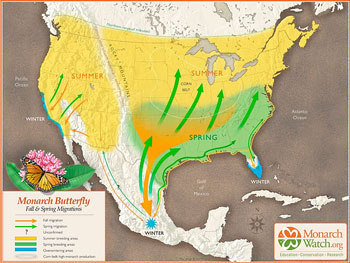Lifecycle

After three to five days, each hatches into a caterpillar and eats milkweed. They develop as caterpillars through instars, getting increasingly larger and then turn into a chrysalis.
After about 10-16 days, the Monarch emerges from its chrysalis as a butterfly.
From late August into fall, Monarchs emerging are of a special generation that migrates all the way to Mexico for winter.
When do we see Monarchs here in Loudoun? We may see a couple between April and June, but our highest numbers are late July through September.
Habitat Needs in Loudoun


Monarchs are especially attracted to gardens and landscapes that have both nectar plants and milkweed. They need the milkweed to lay their eggs on and the nectar plants to feed on as adults.
Milkweed: The only species of plant Monarchs lay their eggs on and the only plant they eat as caterpillars.
If you don’t have milkweed, then you will not have Monarchs.
Nectar Plants: Nectar plants are critical through the summer and fall for adult Monarchs as a food source. Goldenrods and asters in particular play a critical role as a late fall bloomer that also provide Monarchs with secondary toxins that help Monarchs survive their journey to Mexico and overwinter there.
The Great Migration
In late summer and early fall, Monarchs fly as far as 3,000 miles from Canada (2,000 miles from Loudoun) to a tiny area in high in the mountains of Mexico to overwinter.
Their flight is a dangerous one but those that make it rest through the winter on Oyamel trees, conserving their fat.
In late February, they start to stir and nectar in Mexico for 3-4 weeks. They mate and then start the journey north. The majority make it to Texas and the Midwest where they lay their eggs on fresh milkweed, and soon die.

Their young carry on the relay of life for this species, traveling further east and north, laying eggs on milkweed.
By June or July, here in Loudoun we see the grandchildren or great grandchildren of the overwintering population in our gardens.
Habitat Needs in Mexico

In Mexico, the Monarchs go to a mountain area north west of Mexico City and rest for the winter in cool forests of Oyamel trees at an altitude of approximately 10,000 feet.
During their winter slumber, they need rich forest that keeps a steady temperature that’s not too warm and not too cold.
They also need water to metabolize their fat, and some nectar plants to prepare for the Journey north in spring time.

